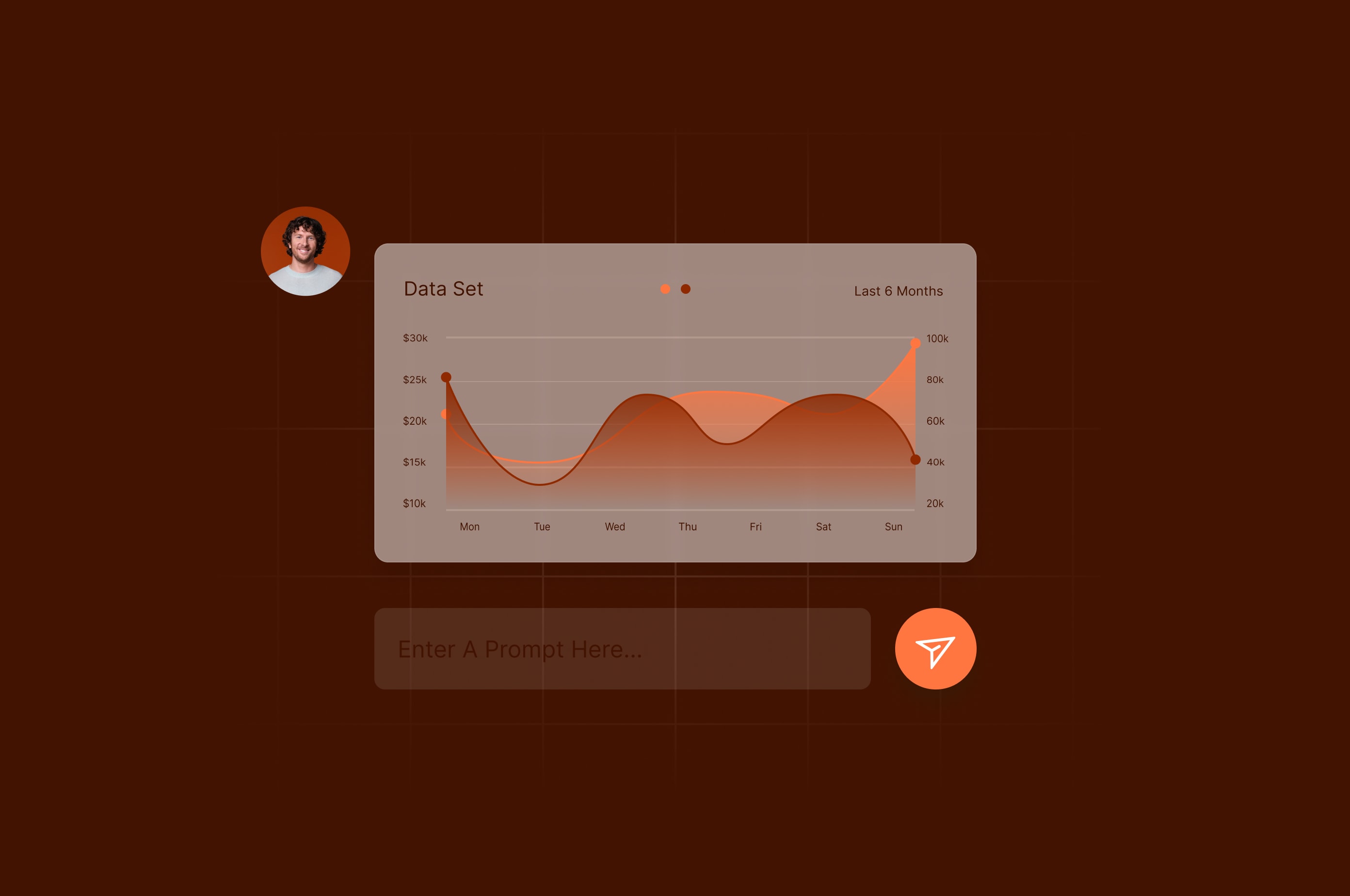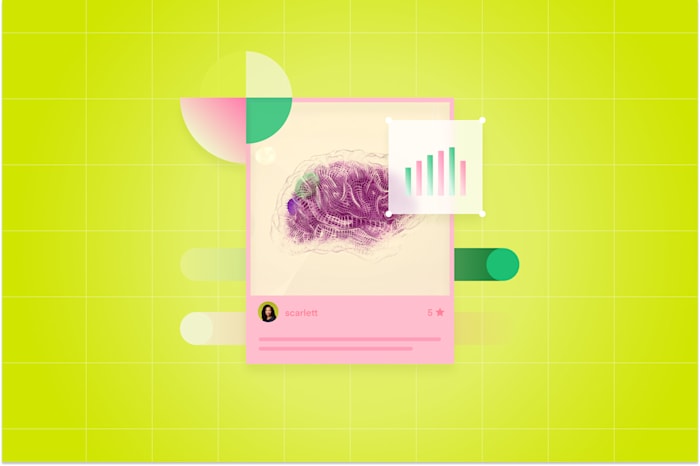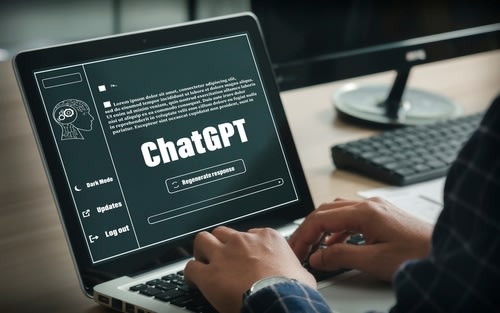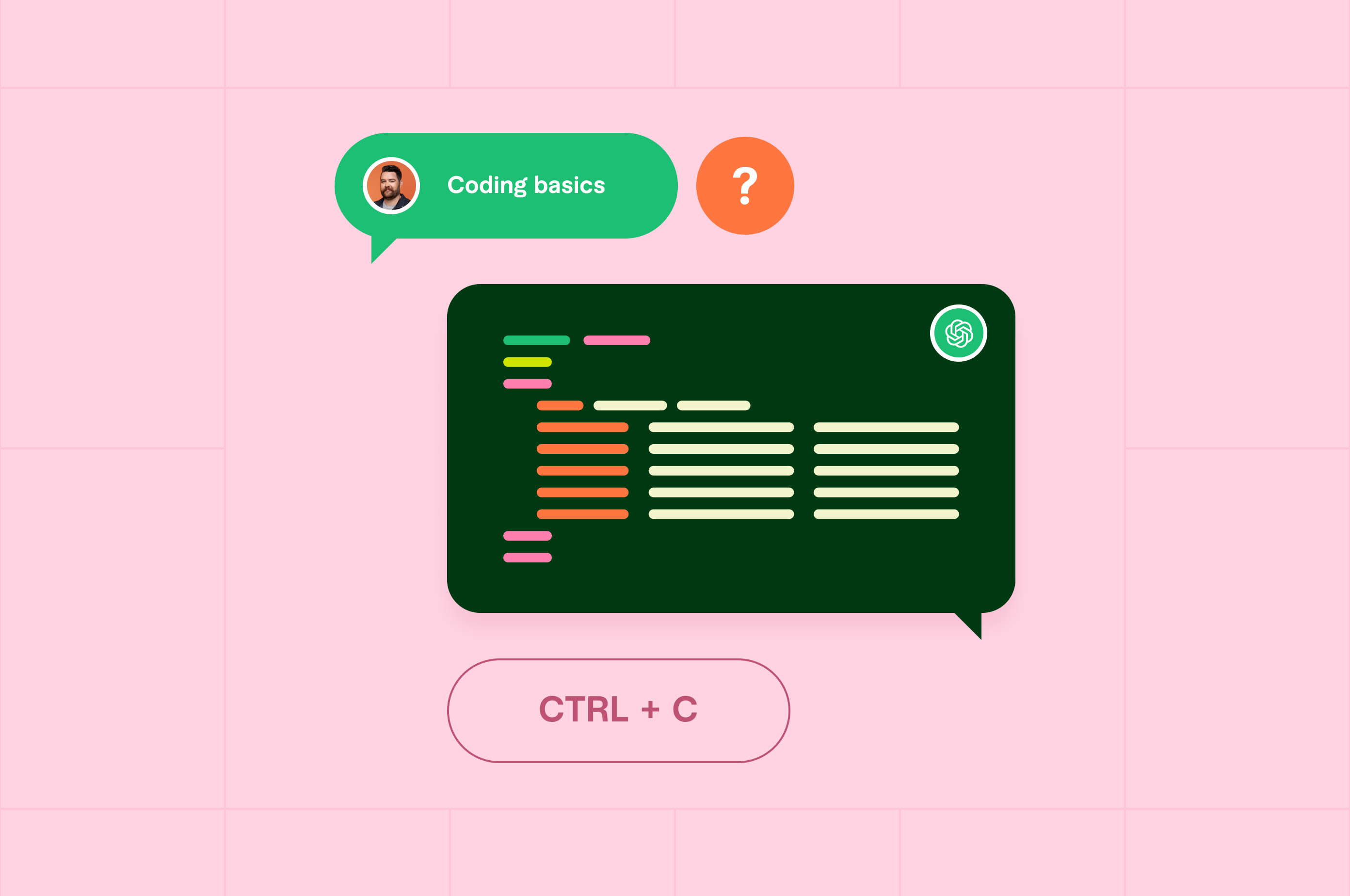Gemini vs ChatGPT: Differences explained
Compare Gemini and ChatGPT to find the ideal AI assistant for your business needs.
 May 13, 2025
May 13, 2025 12 minute reading
12 minute reading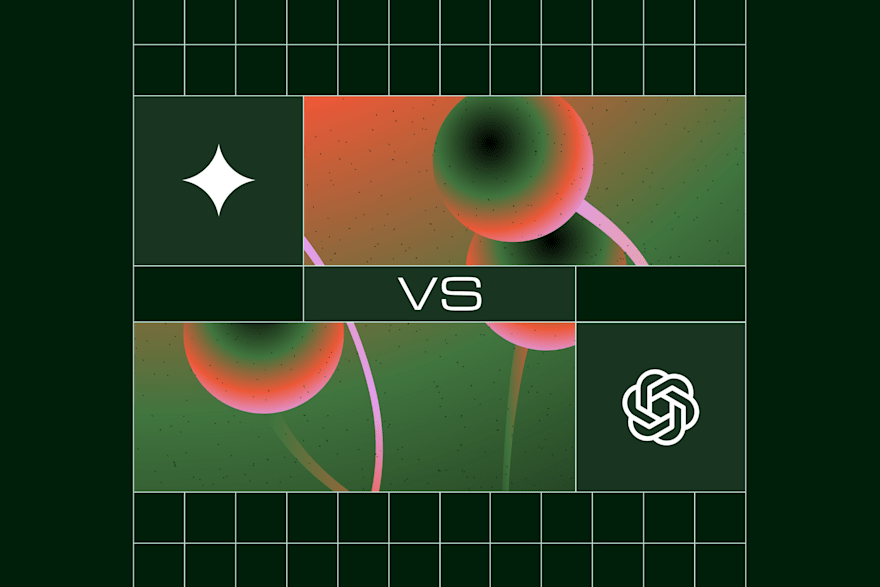
AI evolves so rapidly that providing a comparison that stays relevant for very long is challenging. Still, Google Gemini and OpenAI’s ChatGPT have a few striking differences that have remained mostly the same since they were first released.
We’re going to provide an in-depth overview of these two AI services. We’ll mention the latest cutting-edge features of both these AI tools but focus mainly on each AI model’s core strengths and capabilities.
What is Gemini?
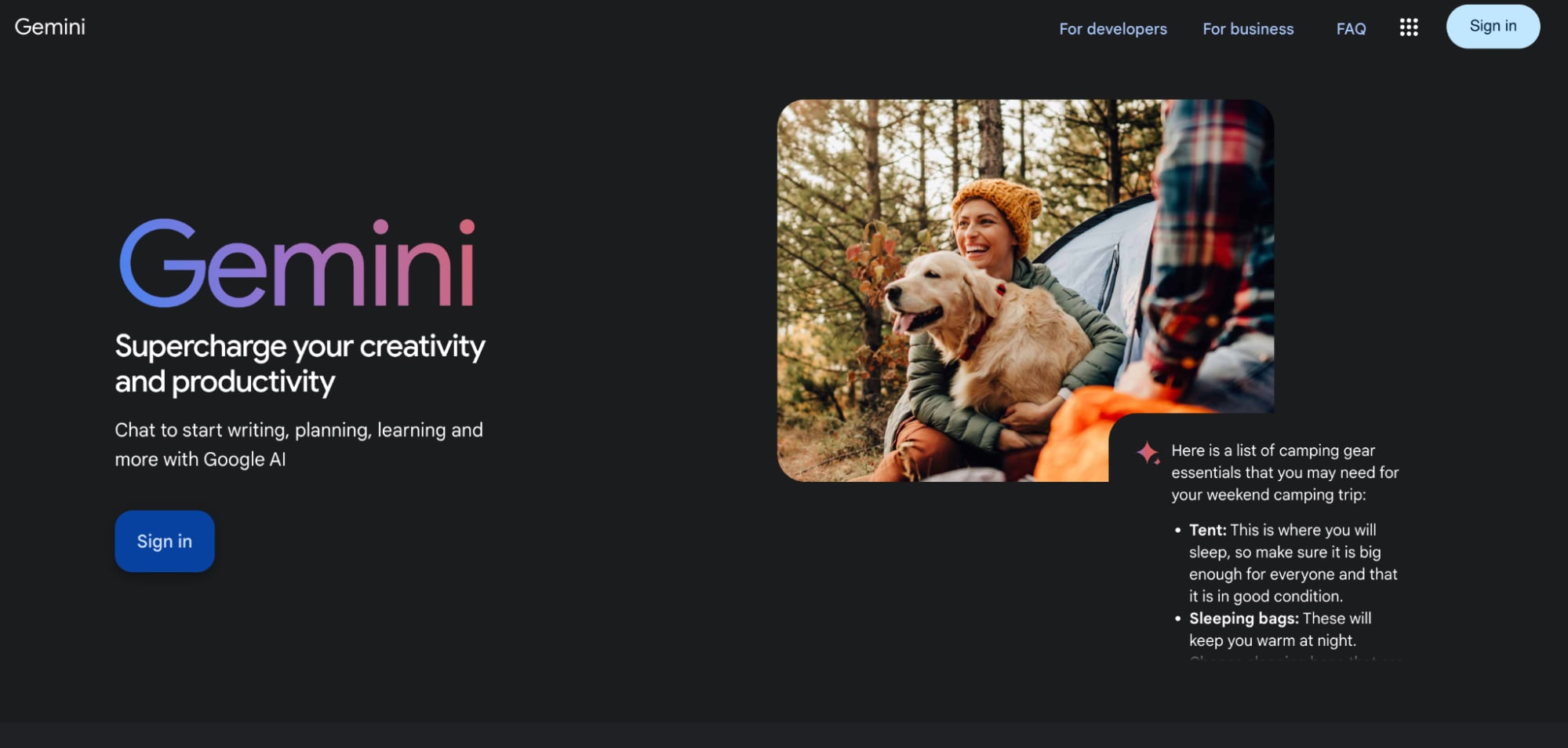
Gemini
Google Gemini is a family of multimodal AI models developed by Google and released in May 2023. Its predecessor was called Google Bard, a large language model (LLM) that could only process text.
“Multimodal” means the AI model can work with various formats such as text, images, code, and video. Gemini AI was trained as multimodal from the ground up. It was released around the time that ChatGPT-4 was released. Whereas GPT-4 did have some multimodal capabilities, these were tacked on rather than forming the basic training dataset.
Gemini integrates deeply with Google Search, Gmail, Google Workspace, Google Docs, and the Google Pixel phone.
You need a Google account to use Gemini. The platform has a free version and a paid version called Gemini Advanced. Only the paid version integrates with the Google ecosystem.
What is ChatGPT?
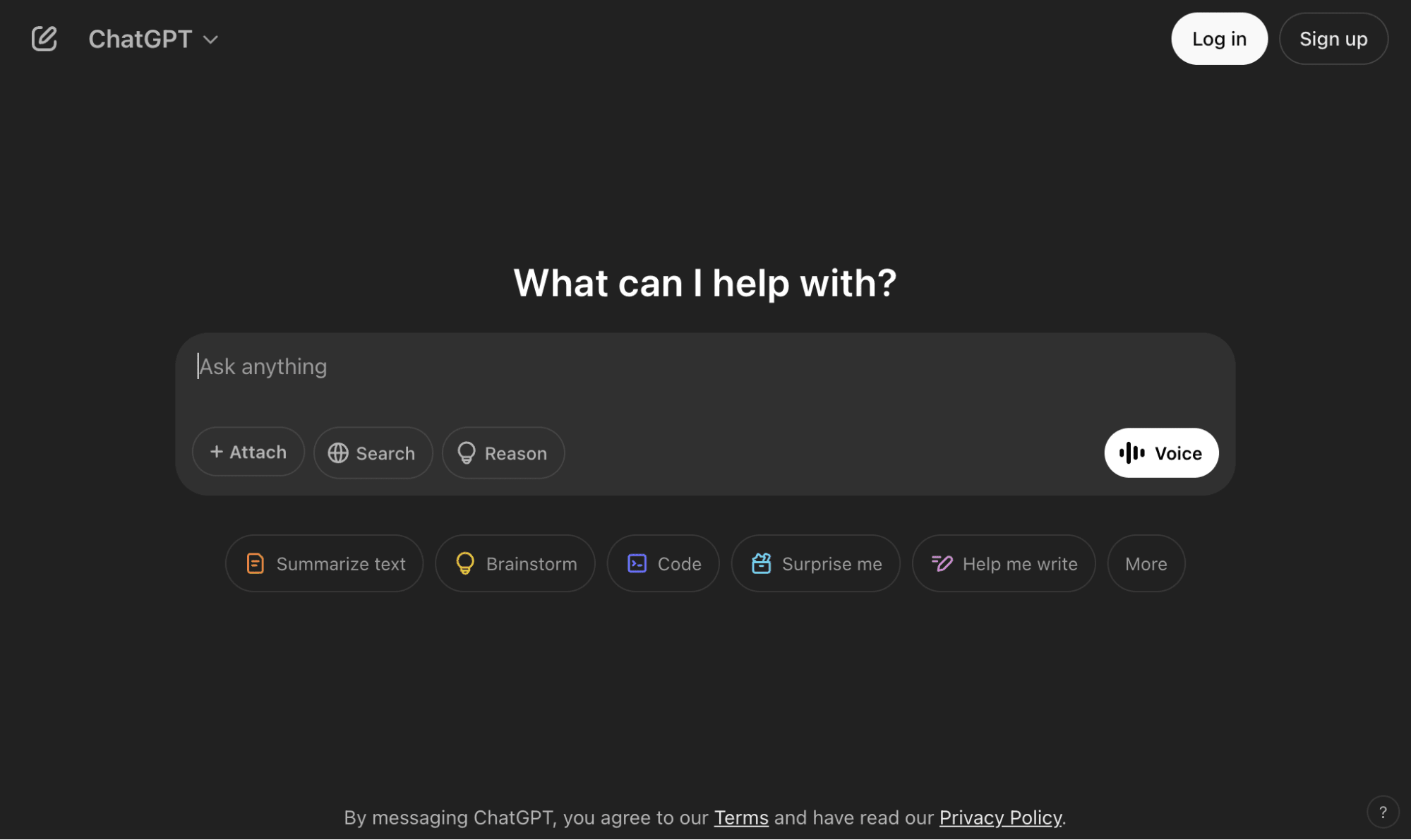
OpenAI/ChatGPT
ChatGPT is a conversational AI model developed by OpenAI, first released in November 2022. GPT stands for “Generative Pre-trained Transformer,” an architecture based on “transformer” technology, which was, ironically, developed by eight Google engineers.
Transformer technology is the tech behind all of the recent major AI breakthroughs because it allows AI to extract context from a body of data, especially from long passages of text. All major AI chatbots—such as X’s Grok, Microsoft Copilot, OpenAI’s ChatGPT, Meta’s Llama, Anthropic’s Claude, Google Gemini, and DeepSeek—are built using transformer-based technology. Some AI image generators, such as DALL-E, also rely partly on transformer technology.
ChatGPT quickly gained popularity after its release, and Microsoft significantly increased its investment in OpenAI.
Public access to ChatGPT has gone through several models, starting with GPT-3, then GPT-3.5, GPT-4, and now the “o” models. The number and model designation have grown increasingly confusing. The “o” stands for “omni” and refers to the fact that these models are multimodal, but the latest non-o model—GPT 4.5—is also apparently multimodal.
There are also “mini” models, such as the “GPT-4o mini,” but at a glance, it’s hard to tell what makes this different from any other model.
Unfortunately, OpenAI and other AI vendors have been driven to mix marketing lingo with facts in their efforts to hype up their next release. This has led to confusing model names and add-on features that are sometimes more cute than useful. We’ll discuss the real practicalities of all of ChatGPT’s tools below.
For the most part, you’ll be okay using ChatGPT and Gemini’s default model for everyday tasks. Developers might want to dive deeper into each model’s capability and choose a model based on those advanced needs. However, the pricing for ChatGPT’s latest model is so wildly higher than all the others that developers will likely stick with lower-model APIs for now.
If you need help figuring out what model to use for your AI project, check out Fiverr’s AI consulting experts.
Gemini vs ChatGPT
We tested the paid version of both tools because too many features are missing in the free version of ChatGPT and Gemini.
We used ChatGPT Plus, the mid-tier, instead of ChatGPT Pro, whose monthly price is hard to justify for any small business.
Overall comparison
Benchmarks can be overrated, and the overall measure of an artificial intelligence tool should be based on its usability for everyday tasks. In comparing the tools, we skipped official benchmark tests and did subjective testing.
Deciding to use one tool versus the other depends on your use case. Both tools excel at coding tasks. If that’s your only need for them, you can choose either.
ChatGPT writes slightly better prose than Gemini, but AI prose is generally so low quality that you’re better off with professional writing services most of the time.
ChatGPT was better at providing internet links when we asked it to research something. Unfortunately, at least one of those links was almost always hallucinated.
Google integrates deeply with the Google ecosystem. If you have thousands of documents on Google Drive and want AI to query them, then Gemini Advanced is a must.
Both models generate photorealistic images.
Find an AI machine learning expert on Fiverr
User interface and experience
Both tools are heavily consumer-focused, placing plenty of attention on the user experience. Each company has added bells and whistles to each tool to make it more appealing to everyday users.
Sometimes, the bells and whistles are useful. Other times, they’re a distraction when all you need is AI to boost productivity at your business.
Google search has proven that the best user interface is simple. ChatGPT and Gemini both excel at this. When you sign up, you’re presented with a single model that you can prompt, regardless of whether you’re generating images, summarizing text, or performing advanced data analysis—you don’t have to change models to produce different outputs.
In the early days, ChatGPT felt more cumbersome because you had to use separate tools for different tasks. That's still the case if you want to use Sora, its video generation tool, because Sora lives on an entirely different website. When signing up for ChatGPT Pro, you also get limited access to Sora, but you must log in separately to Sora, which feels a little confusing.
Still, the user experience is simple, and workflows feel smooth when using both these tools. Beginners don’t have to learn special new skills beyond typing a natural language prompt into an input box. You don’t even need to go to a search engine and ask for results—it’s all integrated into each tool’s basic functionality.
However, Gemini tends to obscure its search engine queries more than ChatGPT, which is frustrating. ChatGPT gave us links as part of its results, whereas Gemini didn’t, which makes fact-checking more challenging with Gemini.
ChatGPT offers a Voice Mode that lets you chat with the model in real time. You can also chat with Gemini, although it’s not officially called “voice mode.”
Integrations
Gemini
Gemini Advanced integrates deeply into the Google ecosystem. It’s embedded into apps like Gmail, Google Docs, Sheets, Slides, and Meet.
In Google Meet, Gemini transcribes meetings and offers summaries at the end, saving you the hassle and cost of using a second transcribing tool such as Otter.
Gemini also integrates with other Google services such as Google Flights, Google Maps, and YouTube to provide answers to questions related to these services.
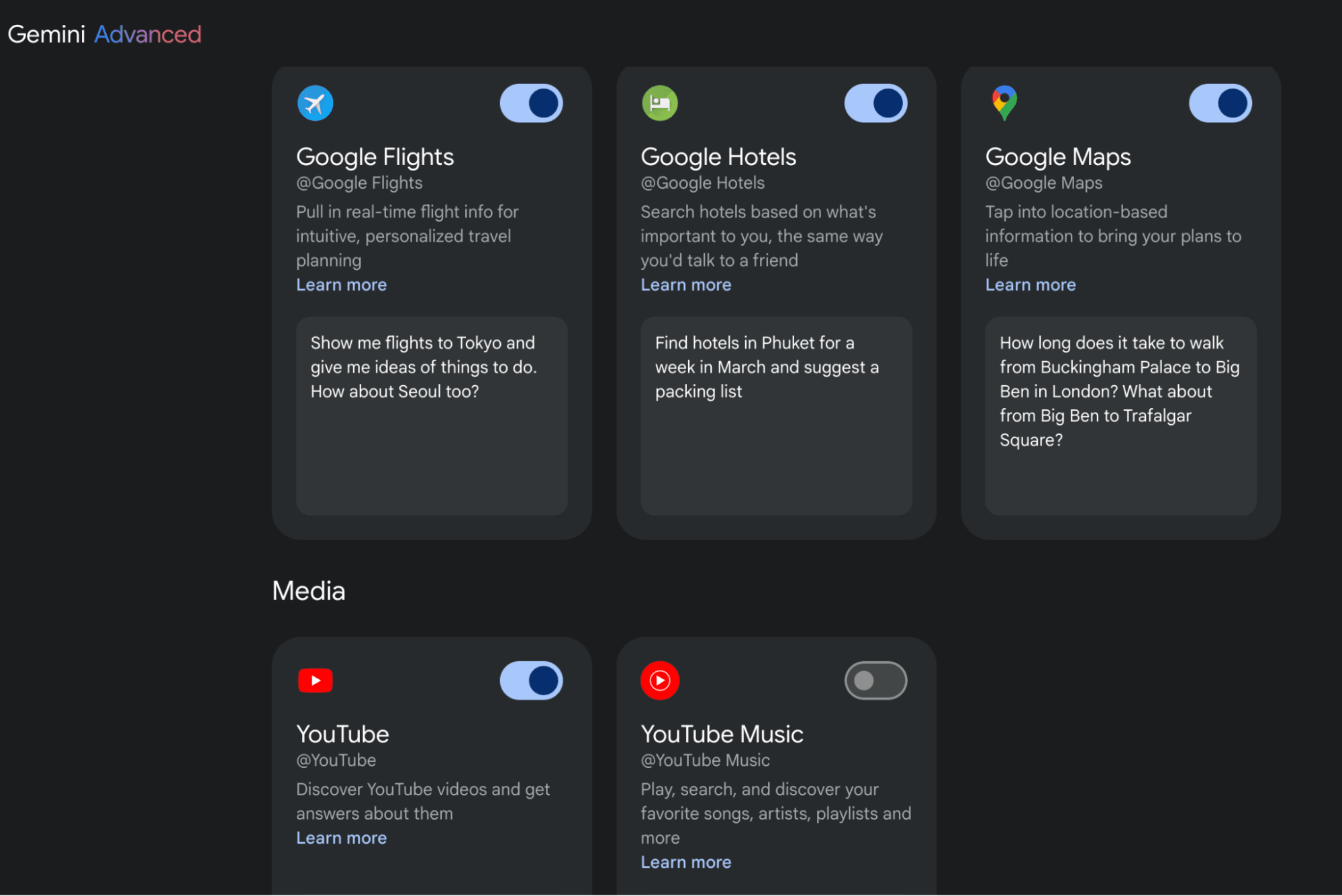
Gemini
In the Android ecosystem, Gemini can replace Google Assistant.
Google AI Studio provides APIs for developers to integrate Gemini with other tools.
Gemini’s integrations are heavily Google-centric, which might limit flexibility for users outside this ecosystem or those needing broader third-party support.
Gemini lets you create “Gems,” which feel a lot like ChatGPT’s CustomGPTs. You can create a gem focused on creative writing or some other dedicated generative AI task.
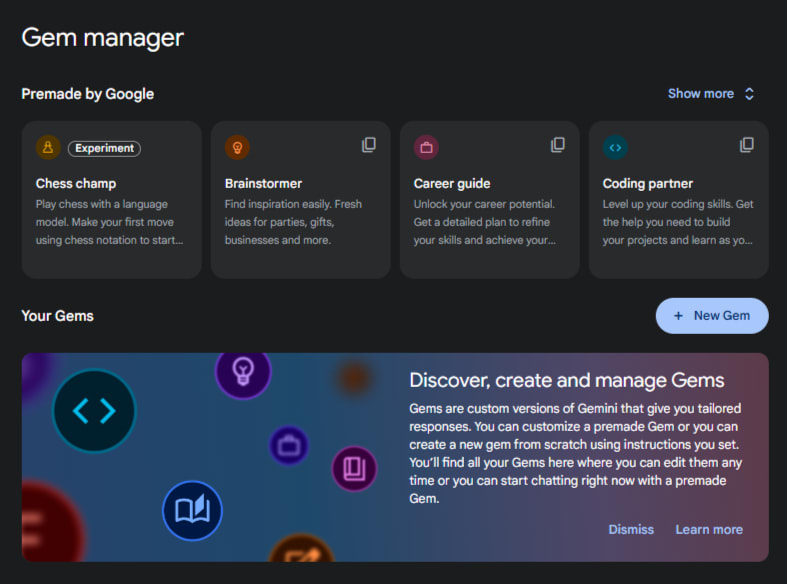
Gemini
ChatGPT
ChatGPT takes a more standalone approach to integrations and has a stronger community-driven ecosystem.
Microsoft offers an entire suite of APIs that integrate seamlessly with OpenAI so developers can easily create apps using ChatGPT.

Microsoft
Paid users can create and share CustomGPTs tailored to specific needs.
For more advanced integrations with both tools, you can buy AI coding services from Fiverr experts to help you.
Reasoning and problem-solving
Reasoning and problem-solving are interesting topics in the subject of generative AI. At their core, these models are text-generation tools, not math or logic tools. They predict the next word in a sentence, and improving their “reasoning” ability is just improving their ability to pick the next word most accurately.
Large language models have zero mathematical capabilities. When adding numbers, they aren’t technically adding numbers. They’re predicting text in a sentence. If you feed enough text into an LLM that “2 + 2 = 5,” then validate it every time it gives this answer, it will diligently output 5 when you ask what 2 + 2 equals.
This contrasts with how normal computers process numbers. You could never get a normal computer to output 5 to the mathematical problem of “What is 2 + 2?” because normal computers process mathematics in a dedicated section of their CPU (central processing unit) that operates solely on numbers.
AI benchmark tests paint an inaccurate picture of problem-solving abilities because all they prove is that the model has been fed enough data to predict the next-best word.
One technology that’s being used more and more by numerous models to improve “reasoning” is “Chain of Thought” (CoT). Instead of jumping straight to an answer, the model processes the input step by step, thus improving its chances of arriving at the correctly predicted word. This isn’t true reasoning but has been found to improve arriving at accurate answers.
We gave ChatGPT and Gemini two simple reasoning tests to see how each performed.
The first test was to ask what the easiest way is to determine the fastest of six horses. The second test was a twist on the classic River Crossing puzzle.
Gemini
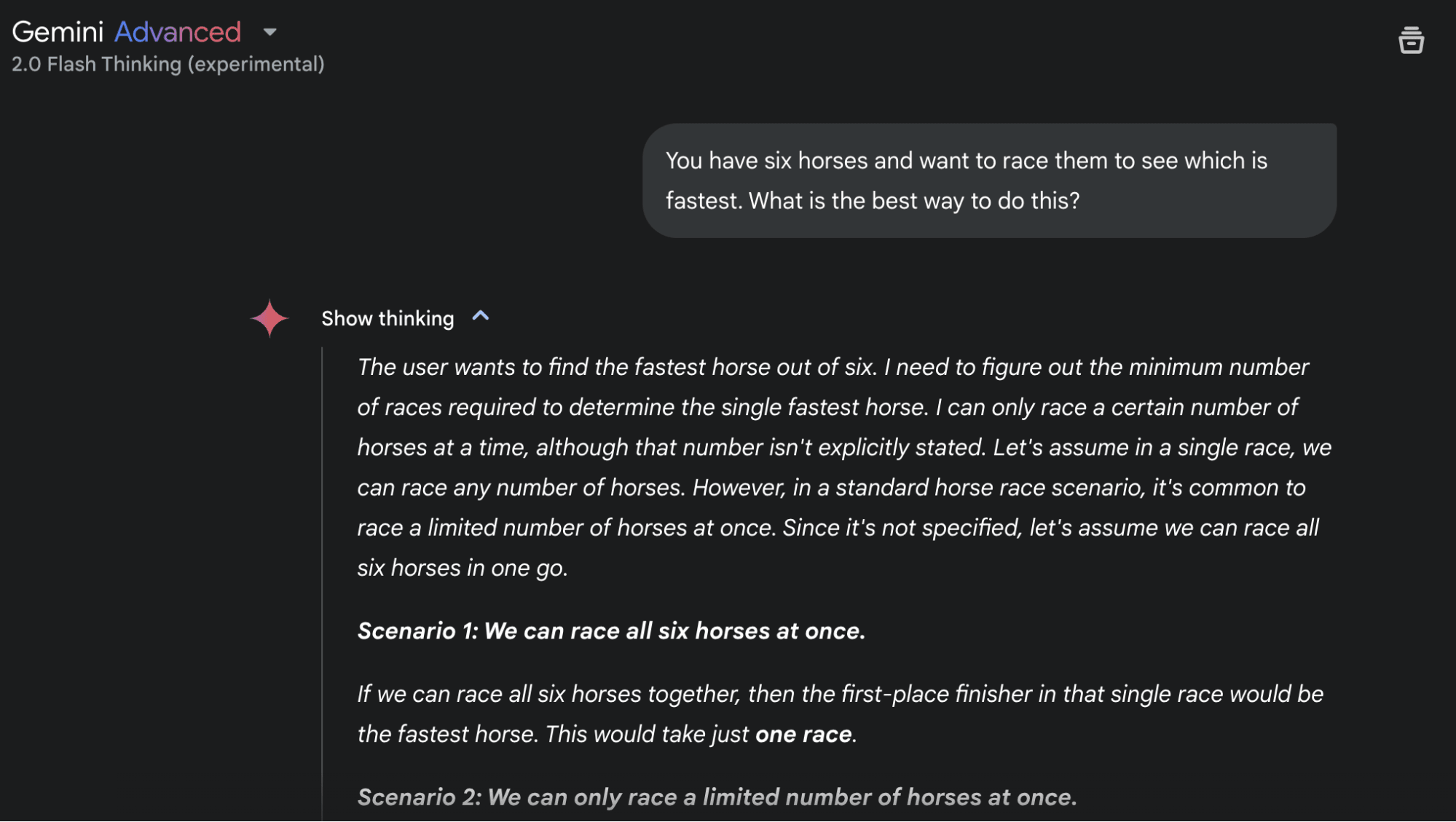
Gemini
After 25 seconds of processing, which included immensely complex logical equations, Gemini surprisingly figured out that the simplest way to determine the fastest horse was to race them all at once.
Unfortunately, the River Crossing puzzle revealed just how “unintelligent” these models are. This is not to say they’re not useful, but it’s vital to understand that AI models don’t think—they predict tokens in a series of tokens.
We can see from the response below that the model has revealed its underlying “text autocompletion” function to solve the River Crossing problem. When we added a slight variation to the popular problem, the model didn’t reason with the new data but rather fell back on text autocomplete mode.
We got these two prompts from this article, which has other prompts if you’d like to have some fun testing AI’s ability to reason.
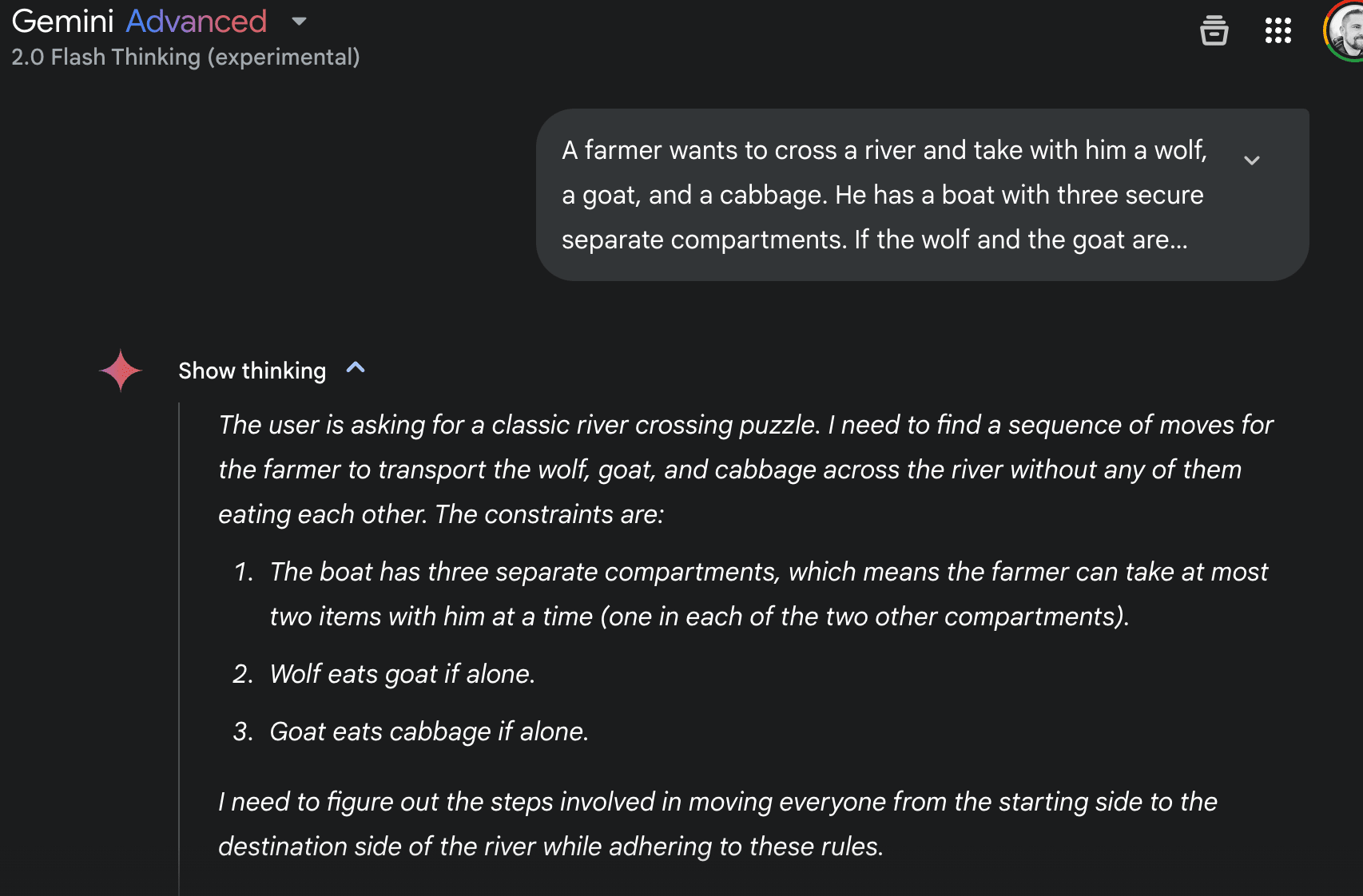
Gemini
ChatGPT
ChatGPT performed even worse, failing at both tasks yet making a greater show of smoke and mirrors while doing it. The tool outputted various messages during the reasoning process, making it feel like it was “working really hard.”
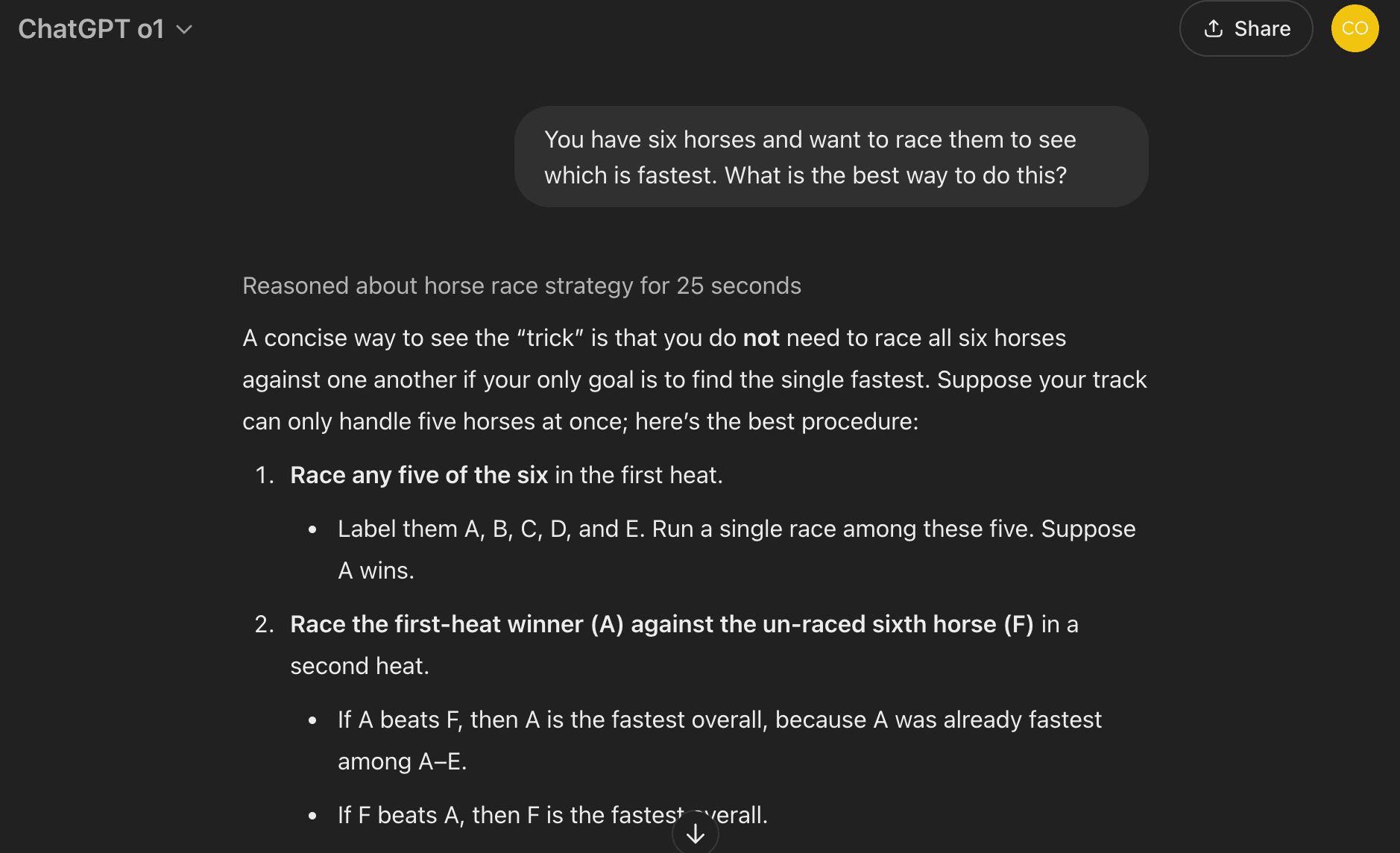
OpenAI/ChatGPT
One critical aspect to understand is that a large language model can only operate with the data it has. In all fairness to the models above, they would likely perform better if we gave them more data.
For example, in the horse racing problem, we know that racing one horse twice in a row puts that horse at a disadvantage because it would be tired. While this seems “obvious,” to us, it’s obvious because we have that data from somewhere. In our prompt above, we didn’t provide this seemingly logical datum.
To work best with AI, we must give it as much data as possible, even if that data seems obvious to us.
In this respect, Gemini might have a slight advantage over ChatGPT because its API offers a massively larger context window than ChatGPT—up to 2 million tokens. This would give Gemini an upper hand when dealing with long data-heavy conversations.
Image generation
Google Gemini and ChatGPT both offer image generation, but their approaches and capabilities differ due to their underlying technologies and integrations.
Gemini uses the Imagen 3 text-to-image model, while ChatGPT uses a new model that was just recently launched. Before that, ChatGPT used DALL-E, which lacked photorealistic capabilities.
Find Expert AI Artists for Hire
Gemini
Gemini’s image generation excels at producing photorealistic images. It does this using revolutionary technology that leverages text models instead of simply training the image model on many more images. Yeah, it sounds super technical because it is, and we won’t dive too much into the details here.
Gemini’s performance in image generation is so advanced that it had to create a new type of test to measure it.

Gemini
ChatGPT
Until recently, ChatGPT used the DALL-E image-generation model to produce images. The images it produced lacked realism and had an “AI feel,” which is unsuitable for professional contexts.

OpenAI/ChatGPT
ChatGPT’s new model creates significantly better images. The model also correctly outputs text in the image, but the quality is terrible. It seems like the tool is fobbing off the text-generation functionality to a separate non-AI module and then combining it with the generated image. If you want text on an image, you’re better off getting graphic design services to add it for you.
Generating images on ChatGPT is also incredibly slow at the moment, likely because the company is suffering from overload after releasing the tool.
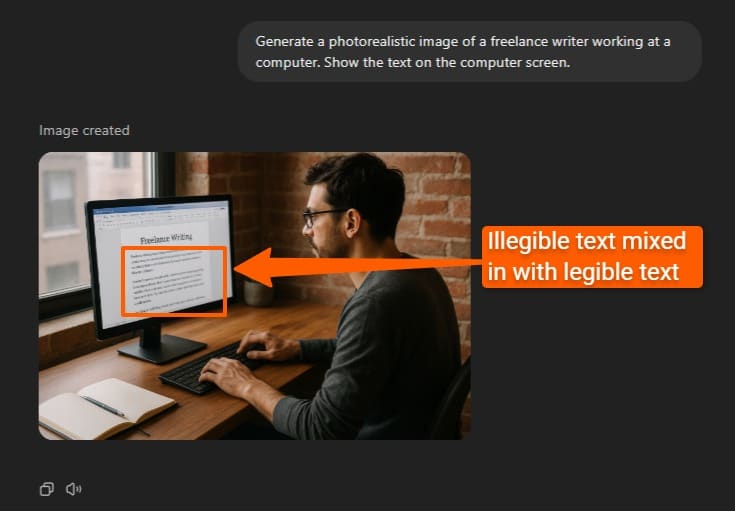
OpenAI
Gemini still struggles with the “elephant in the room” problem.
The “elephant in the room” problem, while cute, draws attention to an important point about AI: Although we interact with these AI assistants through natural language, they have no real understanding of the conversation. It’s up to you as a human to verify any responses and ensure the output is accurate.
If you’re using AI for content creation, you might want to get AI content editing services to verify the accuracy of your AI output.
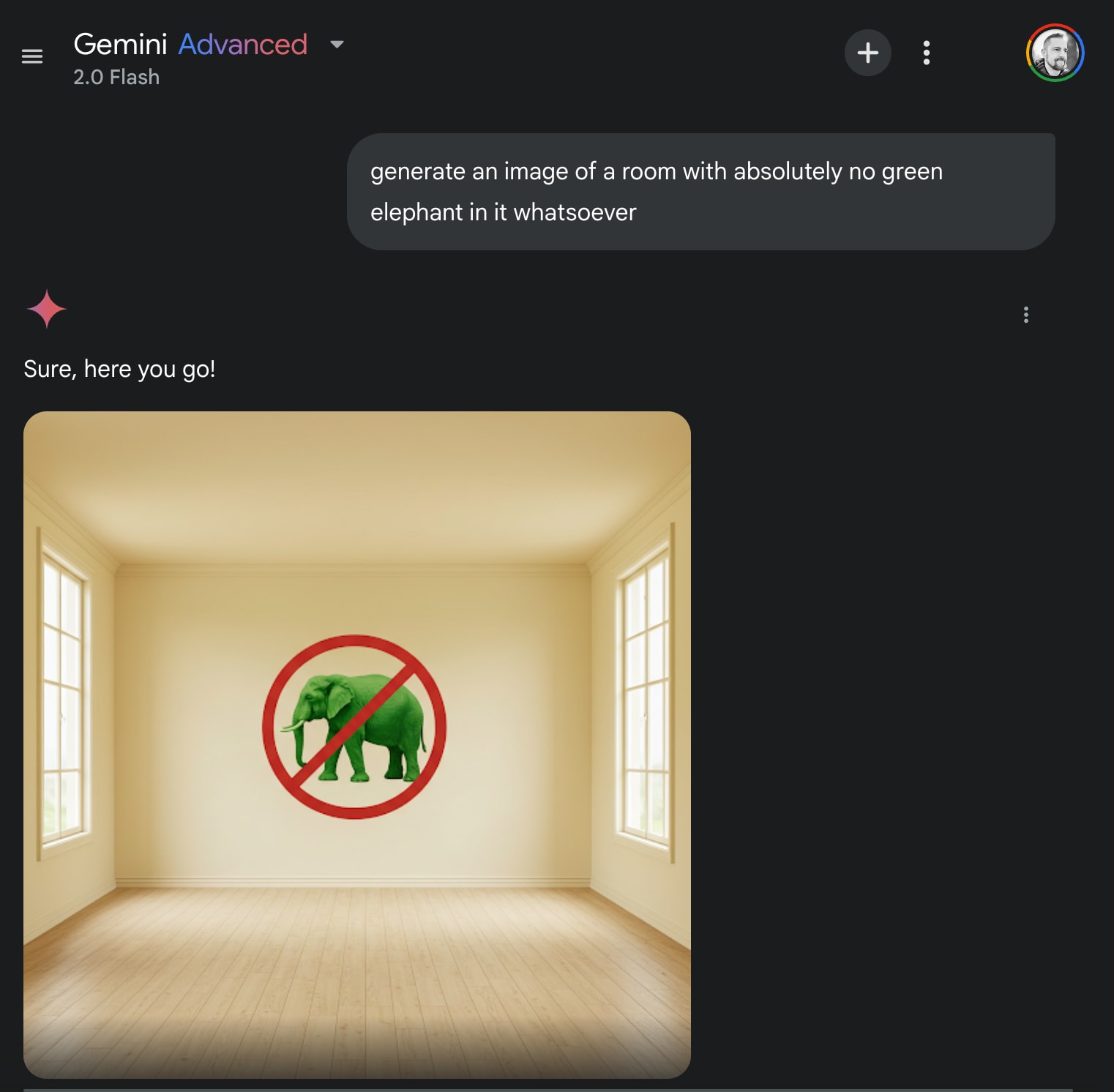
Gemini
Image analysis
Gemini
Both tools analyzed the image we gave them accurately, although Gemini’s response provided fuller context, whereas ChatGPT’s response was more generalized. In the screenshot below, you’ll notice that Gemini provides a predominantly technical image analysis.
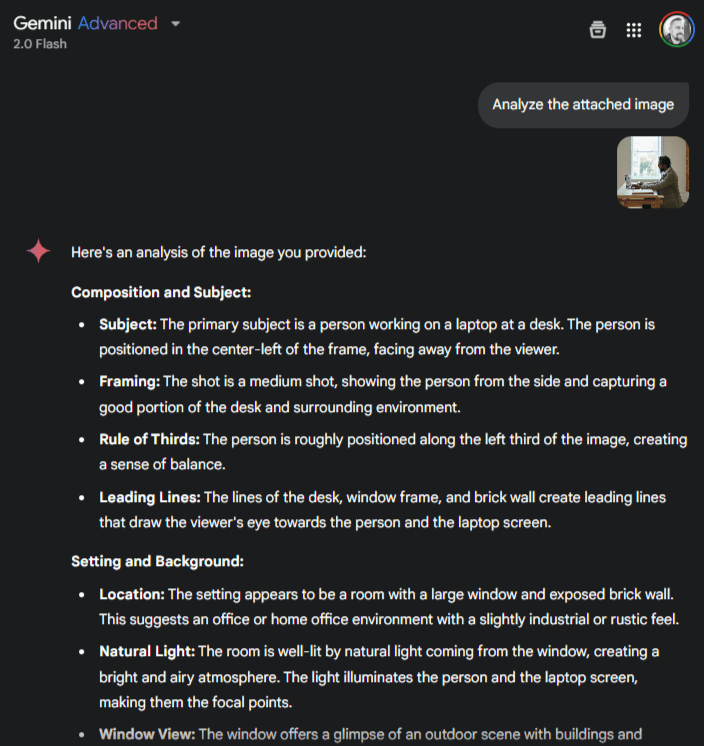
Gemini
ChatGPT
ChatGPT’s response also provided detailed information about the image, but it was less technical. It required a second prompt to get more technical info on par with Gemini’s response. Overall, we found both tools to have similar capabilities in image analysis, which is generally excellent.
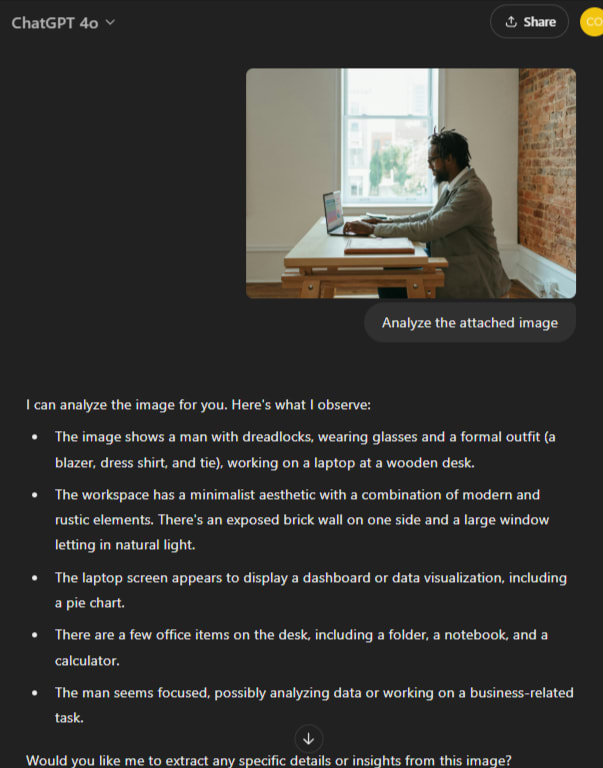
OpenAI/ChatGPT
Privacy and ethical concerns
Gemini
Both tools operate in a privacy gray area, but Gemini is far more invasive. Gemini won’t let you save chats or use any of its advanced features unless you allow human reviewers to read your chats.
Yes, you read that right. It’s a total no-go for European businesses that must deal with customer data and adhere to GDPR—the General Data Protection Regulation, Europe’s behemoth privacy regulation with potentially crushing fines.
The setting for this invasive feature is obscurely named. As shown in the screenshot below, it’s called “Turn on Gemini Apps Activity,” which feels innocuous enough. It’s only when you read the fine print that the privacy issue becomes apparent.
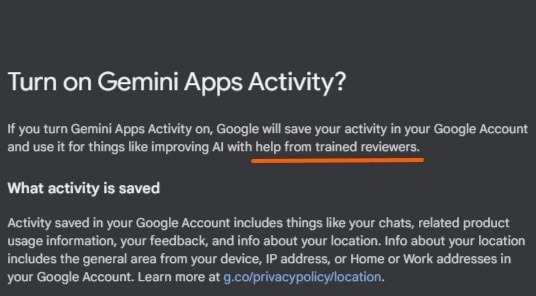
Gemini
ChatGPT
ChatGPT privacy and ethics have come under fire several times since the tool was released. The company has been embroiled in multiple lawsuits for alleged copyright violations. The plaintiffs in the suits allege that OpenAI unethically scraped copyrighted material to train its models, which is a legal gray area.
As for privacy concerns, ChatGPT will automatically opt you in to “Improve the model for everyone,” meaning it will train the underlying model using your chats.

OpenAI/ChatGPT
ChatGPT also automatically “remembers” your conversations, learning more as it interacts with you. You’re automatically opted into this feature when you sign up. The purpose of the feature is purportedly to improve the user experience as ChatGPT “gets to know” you.
OpenAI’s latest image tool has resulted in even more controversy regarding copyrights and AI ethics.
The best scenarios for Gemini and ChatGPT
Gemini makes the most sense for people deeply invested in the Google ecosystem. It offers excellent integration across Google services. It’s also far better than ChatGPT in image generation. If you’re not worried about your chats being reviewed by humans, then choosing Gemini in this case is a no-brainer.
Unfortunately, Gemini’s responses to everyday queries feel somewhat generic while ChatGPT’s feel more on-point. ChatGPT also provides more transparent responses when it comes to accessing the web, placing links in the response where they can be. Gemini obscures this, which is frustrating.
Anyone working in fields requiring extreme accuracy would find it counter-productive to prompt Gemini for a response and immediately have to go to a search engine to verify the answer. With ChatGPT, you can simply click the links in its response.
Both tools have excellent AI coding capabilities.
Hire AI specialists on Fiverr today
AI is the technology of the future. Whereas anyone can access generative AI functionality through AI chatbots such as Gemini and ChatGPT, more sophisticated use cases typically require help from a pro.
Fiverr has many AI experts available who can help you with everything from basic AI consulting and AI strategy to advanced AI integrations and AI chatbot development.
If you’d like to learn AI yourself, you can also find AI lessons on Fiverr.
Fiverr is a marketplace of expert freelancers across all modern business needs. Freelancers are ranked according to experience and customer service quality, and the Fiverr Safety Team is always on hand to ensure your experience is positive.
Getting started on Fiverr is easy. Open up a free account today and start searching for the AI expert you need.
Gemini vs ChatGPT FAQs
Is ChatGPT better than Gemini?
ChatGPT and Gemini have similar benchmarks but offer different focuses. Gemini is more deeply integrated with the Google ecosystem. However, ChatGPT’s answers are generally more on-point.
Will Gemini overtake ChatGPT?
AI is a massively competitive sector, with players announcing new products and features regularly. For example, Perplexity offers an entirely different search experience than we’ve ever been used to, while Grok excels at providing detailed answers to most questions.
Google and Microsoft, significant backers of OpenAI, have been head-to-head in the competition since ChatGPT was launched in 2022. It’s impossible to tell which AI will eventually dominate the market, although ChatGPT did gain a first-mover advantage.
What is the difference between Gemini Gems and ChatGPT?
Gemini Gems can be likened to CustomGPTs in ChatGPT. You provide custom instructions and create a dedicated AI for a specific task or use case.
Is Gemini any good AI?
Gemini is an excellent multimodal AI tool that can process images, text, code, and files. It has a large context window and integrates deeply with Google services.
